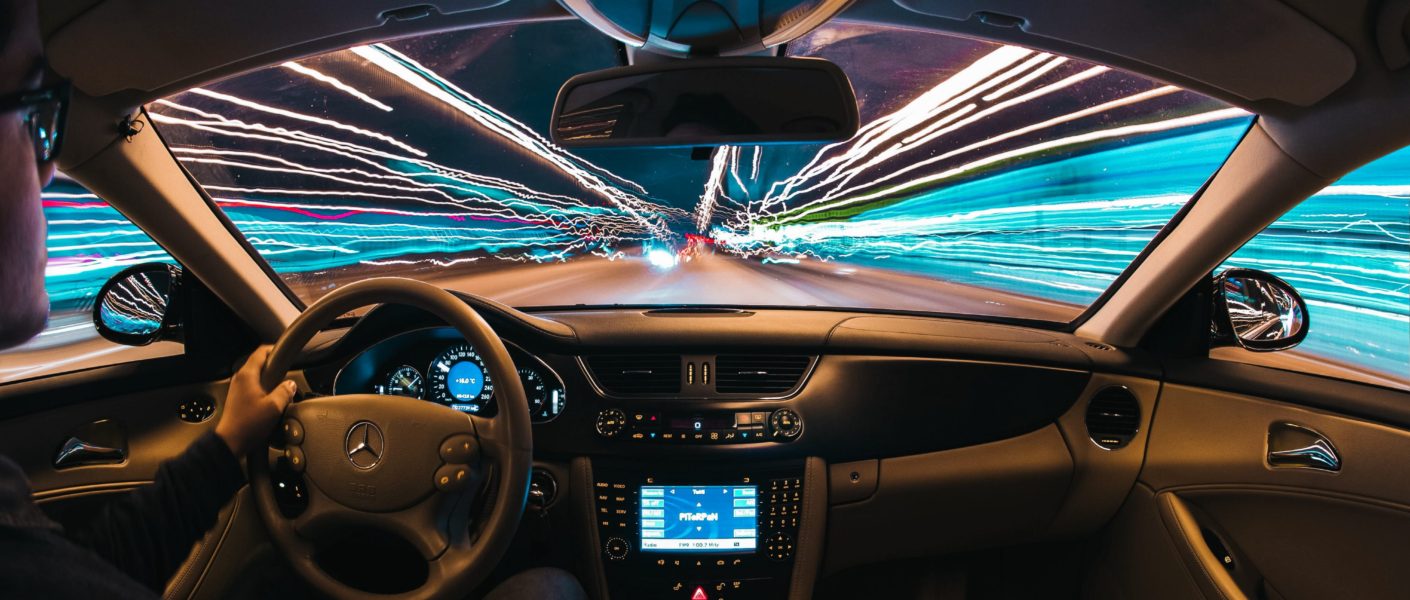It’s the year 2035. Detective Del Spooner auto-cruises through a futuristic tunnel in his spherical, mid-engine sports coupé. Comfortably lounging in his cockpit-like front passenger seat, no steering wheel can be found. No need exists for one in this self-driving transportation contraption of the future.
Via a rocket-like panoramic windscreen, Spooner passively surveys other self-driving cars gliding around him. This futuristic world is not new to him. In fact, Spooner’s laidback demeanor reveals it to be boringly mundane. Boring, that is, until the robot-manned public-transportation vehicles around him slowly move in to encircle him. Already robophobic and technophobic, the detective becomes visibly uneasy.
When futuristic technology fails to capture the dynamics of the unfolding scene, the hero takes action. Suddenly shifting from repose to vigilant, he reaches in front of him to swiftly click a dashboard button, opting out of full automation and into manual operation. From the dashboard, a half-sphere steering wheel slides into view, allowing Spooner to take control of an intensifying robot-attack scene.
Move over Hollywood: Auto-Brands are Winning the Race for Consumer Attention.
In 2004, the year the Audi RSQ concept hit the big screen via the film I, Robot, this scene was a plausible description 2035. Today, not so much. In 2018, this technology is already upon us and, in some ways, has been surpassed.
Until recently, Audi vehicles could only automate simple tasks like taking over continual car longitude and latitude, though not in combination. Then, the brand implemented auto-control for increasingly complex tasks, but only if prompted by human controllers — the same technology that dazzled movie viewers, earning a total I, Robot profit of $300M+ and an Oscar Nomination.
But, viewers hadn’t seen anything yet. While Audi depicted 2035 as the year the auto industry would have mastered the combination of machine learning (ML) and artificial intelligence (AI), the scene falls short of Audi’s 2017 developments. Unveiled at Tech Summit 2017, the Audi A8 is designed to be empathetic, personal, and proactive.
Now, when vehicle-system automation cannot properly address a situation, it doesn’t rely on human judgment to hand over control. AI- and ML-powered bots auto-route these tasks back to the human experts “behind the wheel.” Imagine Spooner’s futuristic vehicle politely prompting him to retake control, even offering a few seconds advanced warning to help him gain a lead on the attack robots plotting against him and all of humanity.
The Auto-Experience Becomes a 1:1 Box-Office Hit.
But this AI- and ML-powered driving experience – albeit seamless, safe, and efficient – isn’t even the best part. When combined, ML, AI, and the Internet of Things (IoT) take the Audi-A8 experience from merely proactive to personal, even before driver boarding.
The Audi Connect Key allows five driver profiles and one guest profile, creating a personalized experience for each via 400 on-road functions. Drivers’ Android phones can be programmed as their vehicle key. In turn, the car greets each driver by name. On-road-driver preferences are then automated and adhered to per the day and type of road travelled.
But, Audi isn’t alone in the race against Hollywood. Daimler’s Smart Vision EQ fortwo car-of-the-future, exhibited at the Frankfurt Motor Show 2017, has no steering wheel, pedals, or manual controls. It is a passenger car, not a driver’s car. And each ride is a personalized experience. A front grill greets each passenger by name. Passengers can then choose and view an in-car movie while riding.
While Audi’s car can perform self-driving mode at up to 37 miles per hour in traffic-jam conditions, by 2021, BMW plans to roll out a self-driving car capable of operating at speeds of up to 81 miles per hour and on divided highways – all without much attention from “behind the wheel.” In other BMW models, from seat positions, store stops, and location- and weather-based proactive driving, future ML-, AI-, and the IoT-powered cars will fulfill even the smallest passenger preference or safety need.
Across the Customer Journey, ML, AI, and IoT are Winning Auto-Consumer Accolades.
While we’ve seen ML, AI, and the IoT dazzle in the boarding and on-road Audi-consumer experience, other auto brands are partnering with tech brands to ensure behind-the-scenes customer experiences match road-time thrills.
BMW partnered with IBM Watson, gleaning data to personalize the driver experience beyond the road. Future cars will self-diagnose vehicle maintenance or repair needs and fix themselves. The IoT will also allow car brands to automate system updates, saving car companies and their passengers time and money in an unfortunate recall event.
For tasks that can’t be resolved in-vehicle, software solutions like WorkFusion’s artificial-intelligence and machine-learning powered Robotic Process Automation (RPA) create a powerful partnership between the IoT and auto-service providers. From Procure to Pay and Customer Onboarding, to claims processing, automated business tasks create a seamless and personal auto-brand experience.
With the ability to process unstructured data from connected cars, for example, auto-insurance providers that partner with RPA-software firms can glean information about connected-car usage, mileage, accident conditions, and other pertinent data to automate claims, creating a hassle-free, timely, and transparent payment experience.
The result: Well before 2035, with the IoT and RPA technology, Detective Spooner wouldn’t have to stall his post-attack efforts to stop a robot apocalypse. Instead of attending to endless heaps of claim papers to prove lack of fault, his insurance provider would automatically gain necessary claim information in real-time and in optimal format, ensuring seamless, on-time, and error-free processing and payment.
Auto Brands Secure First Place in the Race Against Hollywood.
ML and AI are taking over the auto-experience for an end-to-end seamless and personalized experience Baby Boomers once believed impossible during their lifetimes. Throw in the IoT and auto experiences become increasingly seamless and personal.
BI Intelligence forecasts that 381 million connected cars will hit the road by 2020. With the technology already here, today’s auto-consumers don’t care to just watch futuristic-movie car scenes, living vicariously through the stories’ heroes. They want to live their potential.
So, auto brands, take a BMW-style leap to embrace the revolution. Begin small with select partnerships. Then build on them. Win auto-consumer accolades by partnering with brands at every stage of the auto-consumer journey to create a seamless and personalized experience from before-purchase to well-after.
This article was first published on Business2Community.com.




Im thankful for the post. Great. ekdceddebaad
Thank you for reading!